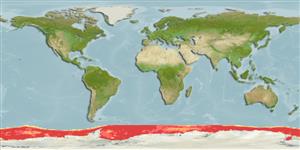Classification / Names
Nomi Comuni | Sinonimi | Catalog of Fishes (gen., sp.) | ITIS | CoL | WoRMS | Cloffa
Actinopterigi (pesci con pinne raggiate) >
Perciformes (Perch-likes) >
Nototheniidae (Cod icefishes)
Etymology: Pleuragramma: Greek, pleura = side, ribe + Greek, gramma = letter, signal (Ref. 45335); antarctica: Named after the region in which this is common (Ref. 11892).
Ambiente / Clima / Range
Ecologia
; marino; distribuzione batimetrica 0 - 728 m (Ref. 11892). Polar; ? - 2°C (Ref. 6390), preferred -2°C (Ref. 107945); 60°S - 78°S
Southern Ocean: Antarctic Peninsula, South Shetland, Elephant, South Orkney islands, Weddell, Bellingshausen, Ross and Davis seas, Oates, Adélie, Wilhelm and other coasts of East Antarctica to Prydz Bay.
Length at first maturity / Size / Peso / Age
Maturity: Lm ?, range 13 - ? cm
Max length : 25.0 cm TL maschio/sesso non determinato; (Ref. 5179); common length : 15.0 cm TL maschio/sesso non determinato; (Ref. 2121); Peso massimo pubblicato: 200.00 g (Ref. 6390); Età massima riportata: 20 anni (Ref. 5216)
Spine dorsali (totale): 6 - 8; Raggi dorsali molli (totale): 35-38; Spine anali 0; Raggi anali molli: 36 - 39; Vertebre: 52 - 56. Pre-opercular-mandibular canal pores 9 (rarely 10), with 3 (rarely 4) on the mandible. Infraorbital canal with 4+2 pores; lateral line organs (neuromasts) present exposed region between the canal segments, the normal number probably being 4 (rarely 5), but some or all are often missing. Supraorbital canal with 3+1 pores (a second, more posterior pore rarely present in postero-dorsal section); between these 2 supraorbital canal segments is a trough divided by 3 low transverse ridges into 4 shallow depressions; on each ridge is a neuromasts organ. Temporal canal with 1+4 pores; between the 2 segment lies a single exposed neuromast. Supratemporal canal with 1+1 pores; no traces of neuromasts were found in the intervening regions.
Color: In life, pink with a silvery hue, the dorsal surface slightly darker. All fins pale, with clear hyaline membranes. The body becomes silvery with a darker dorsum only after death (Ref. 28937).
Regarded as the only truly pelagic fish in Antarctic waters (Ref. 6390). Larvae and postlarvae occur between 0 to 135 m; juveniles 50 to 400 and adults below 400 m (Ref. 5179). Postlarvae feed mainly on eggs and larvae of copepods; juveniles mainly on copepods, but take also eggs and larvae of euphausiids, polychaetes and chaetognaths (Ref. 5179). Larger items are ingested with increase in size (Ref. 5179). Larval pelagic phase is long (Ref. 28916).
Mature females may spawn for the first time from around 7-9 years of age (Ref. 71843).
Dewitt, H.H., P.C. Heemstra and O. Gon, 1990. Nototheniidae. p. 279-331. In O. Gon and P.C. Heemstra (eds.) Fishes of the Southern Ocean. J.L.B. Smith Institute of Ichthyology, Grahamstown, South Africa. (Ref. 5179)
IUCN Red List Status (Ref. 115185)
CITES (Ref. 94142)
Not Evaluated
Threat to humans
Harmless
Human uses
Pesca: scarso interesse commerciale
Informazioni ulteriori
CollaboratoriImmaginiStamps, CoinsSuoniCiguateraVelocitàModalità di nuotoArea branchialeOtolithsCervelliVista
Strumenti
Special reports
Download XML
Fonti Internet
